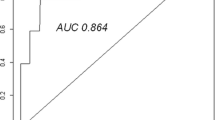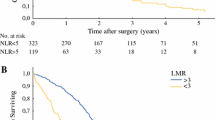Summary
Leukocytosis (WBC counts 10,000/mm3) was detected in 77 out of 252 patients (30%) with ten different types of nonhematological malignancy (NHM) at the time of diagnosis. A full search including serological and bacteriological screening was performed to exclude other possible causes of leukocytosis. Among the different tumors, carcinomas of the lung and colorectum were the most prevalently associated with leukocytosis. Absolute monocytosis was found in 25% of the patients and absolute eosinophilia in only 4.8%. The leukocytosis was attributed mainly to an increase in the mature polymorphonuclears, suggesting a release mechanism of WBC from storage pools by factors secreted or induced by the tumor.
Neither the age nor the sex of the patients affected the incidence or magnitude of leukocytosis. However, the presence of metastases was associated with a significantly higher incidence of leukocytosis (p<0.05). The associated leukocytosis may be regarded as a poor prognostic sign, and was associated with a significantly (p<0.007) shorter survival time. In contrast, absolute lymphocytosis may have a positive effect on the survival time (p=0.01). Tumor-associated leukocytosis may be an additional tumor-associated marker, of value in assessing and monitoring patients with NHMs.
Similar content being viewed by others
References
Banerjee RN (1967) Haematological changes in malignancy. Br J Haematol 13:829–843
Barrett AJ, Barrett A (1975) Bronchial carcinoma with eosinophilia and cardiomegaly. Br J Dis Chest 69:287–292
Barrett O (1970) Monocytosis in malignant disease. Ann Int Med 73:991–992
Burlington H, Heldman CB, Pappas N, Sradduck RK (1983) Tumor-induced granulopoiesis unrelated to colony-stimulating factor. Blood 62:693–695
Check IJ, DeMeesterr T, Vardiman J, Hunter RL (1978) Leukocyte counts and survival in unresectable lung cancer. Lancet II:1317–1318
Dalal PR, Rosenthal R, Sarkar TK (1980) Leukemoid reaction in pulmonary carcinoma. J Nat Med Assoc 72:683–686
Fahey RJ (1951) Unusual leukocyte responses in primary carcinoma of the lung. Cancer 4:930–935
Heitman R, Schottky H (1968) Leukocytosis in brain tumor. Nervenarzt 39:222–225
Huhti E, Saloheimo M (1979) Leukocyte counts and survial in lung cancer. Lancet I:1348
Kimura N, Yoshiyuki N, Yanase T (1982) A high level of colony-stimulating activity in lung cancer patient with extensive leukocytosis, and the establishment of a CSA producing cell line. Scand J Heamatol 28:417–424
Klochkov ND (1963) Changes in the hematopoietic system in lung cancer. Klin Med (Mosk) 41:98–105
Knorring JV, Selroos O, Scheinin TM (1981) Hematologic findings in patients with renal carcinoman Scand J Urol Nephrol 15:279–293
Krumbhaar (1926) Leukemoid blood picture in various clinical conditions. Am J Med Sci 172:519–521
Little JH (1972) Histology and prognosis in cutaneous malignant melanoma. In: McCarthy WH (ed) Melanoma and skin cancer. Government Printer, Sydney, Australia, pp 107–119
Meyer LM, Rotter SD (1942) Leukemoid reaction in malignancy. AM J Clin Pathol 12:218–222
Norcross J (1963) Haematologic manifestations of malignant diseases. Med Clin North Am 47:349–350
Riesco A (1970) Five year cancer cure: relation to total amounts of peripheral lymphocytes and neutrophils. Cancer 25:135–140
Robinson WA (1974) Granulocytosis in neoplasia. Ann NY Acad Sci 230:212–218
Sato N, Asano S, Ueyama Y, Mori M, Okabe T, Kondo Y, Osrawa N, Kosaka K (1979) Granulocytosis and colony stimulating activity (CSA) produced by human squamous cell carcinoma. Cancer 43:605–610
Shoenfeld Y, Gurewich Y, Gallant LA, Pinkhas J (1981) Prednisone-induced leukocytosis. The influence of dosage, method and duration of administration of the degree of leukocytosis. Am J Med 71:773–778
Slungaard A, Ascensao J, Zanjani E, Jawb HS (1983) Pulmonary carcinoma with eosinophilia. N Engl J Med 301:778–781
Snell NJ (1979) Leukocyte counts and survival in unresectable lung cancer. Lancet I:383–384
Suda T, Miura Y, Mizoguchi H, Kubota K, Tokaku F (1980) A case of lung cancer associated with granulocytosis and production of colony-stimulating activity of the tumor. Br J Cancer 41:980–986
Tebbi K, Gross S, Newman AJ (1979) Increased colony stimulating activity in plasma of a patient with lymphoepithelioma metastatic to the liver. Oncology 36:224–227
Author information
Authors and Affiliations
Additional information
This work was supported by a grant in the memory of Yoav Armon.
Rights and permissions
About this article
Cite this article
Shoenfeld, Y., Tal, A., Berliner, S. et al. Leukocytosis in non hematological malignancies—A possible tumor-associated marker. J Cancer Res Clin Oncol 111, 54–58 (1986). https://doi.org/10.1007/BF00402777
Received:
Accepted:
Issue Date:
DOI: https://doi.org/10.1007/BF00402777




